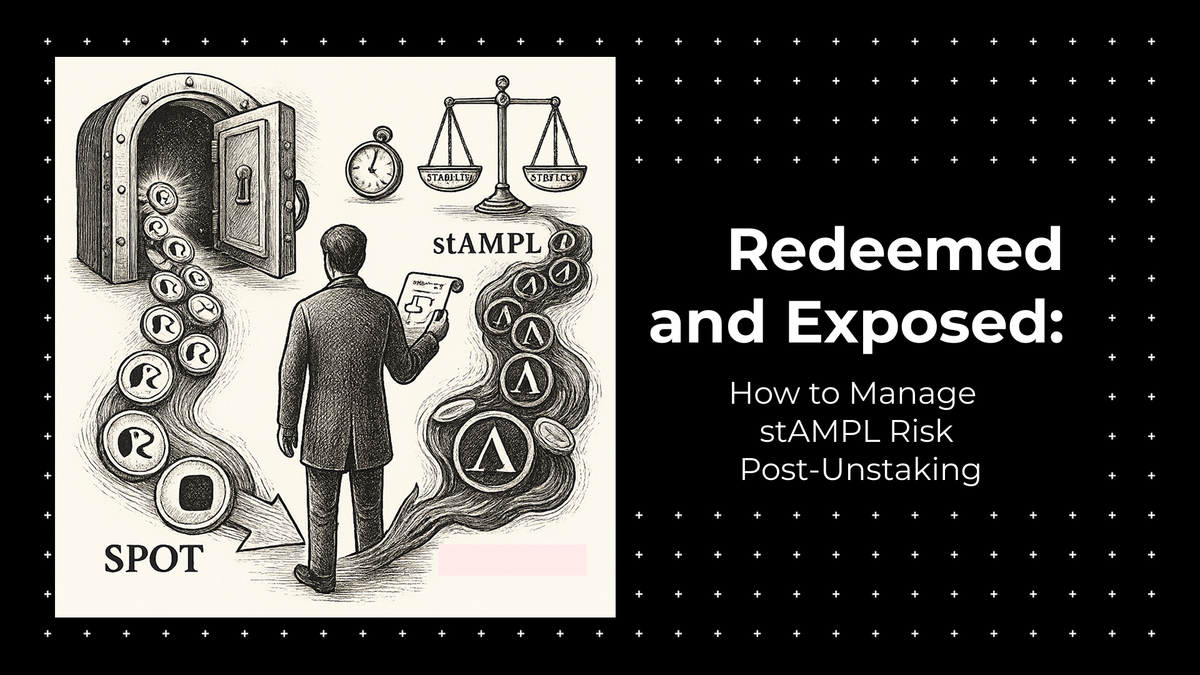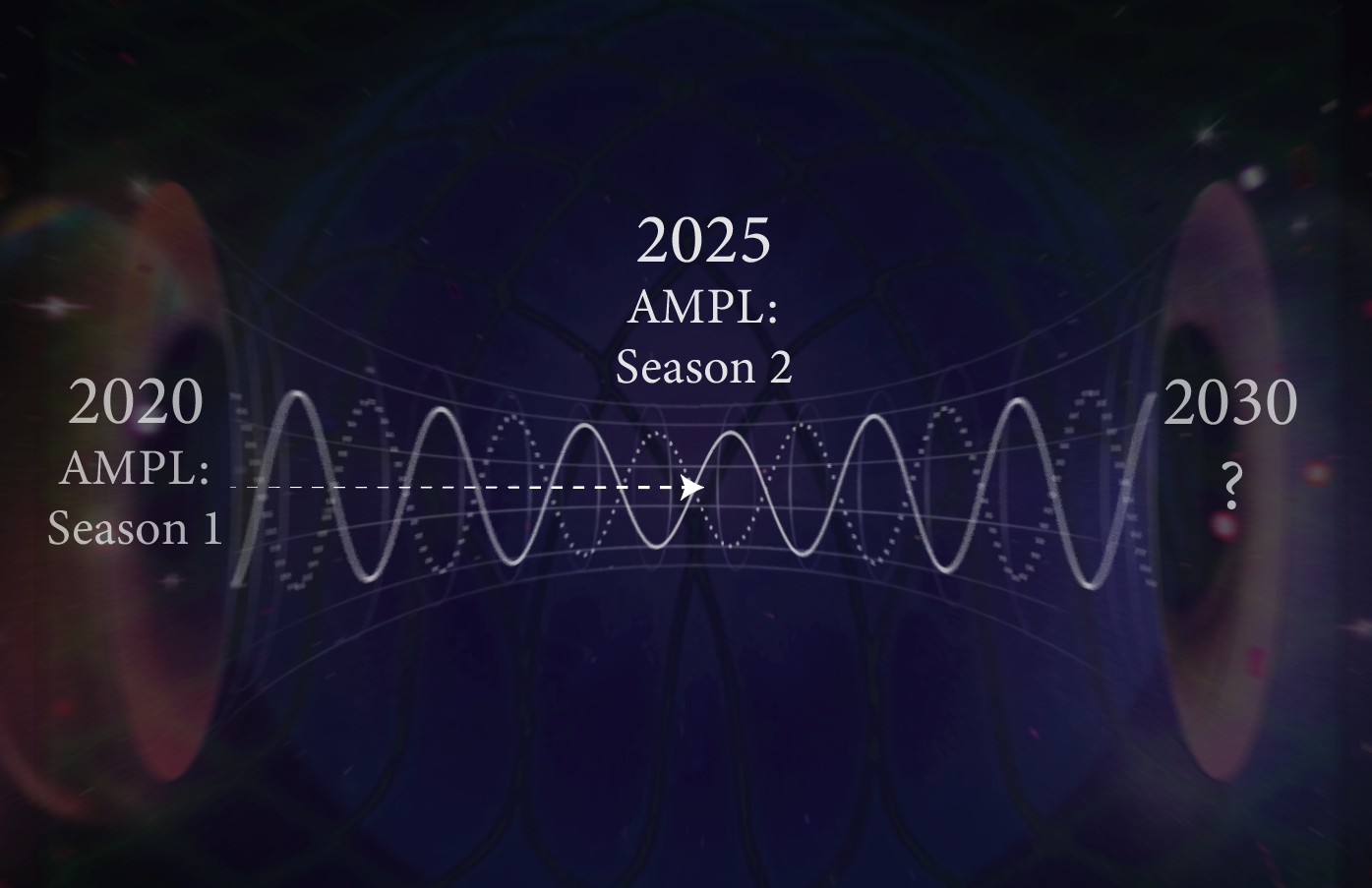Mitigate AMPL Exposure of Redeemed stAMPL

The SPOT rotation vault allows firm believers (affectionately known as degens) in the Ampleforth ecosystem to provide stability to their low-volatility SPOT token by providing the liquidity used to rotate out older tranches maturing soon in exchange for newer tranches maturing later. This action keeps the SPOT token backed by fresh senior (non-rebasing) AMPL tranches. In providing this liquidity, depositors are demonstrating a belief in the continued growth of the ecosystem, and are rewarded with a an increase in percentage ownership share in the protocol, by means of the stAMPL multiplier. The mechanics of the rotation vault are beyond the scope of this article; uninitiated readers are encouraged to gain further understanding of the stAMPL vault mechanics here: The SPOT Rotation Vault
Whilst wearing rose tinted glasses during the seasonal bull markets, having an enhanced AMPL position in stAMPL makes perfect sense while the period of “numbers go up” is in play. During positive rebase phases, for every positive rebase that AMPL endures, stAMPL holders experience a multiplier effect, proportional to the make up of junior tranches & AMPL in the vault. As more wallets flash mint SPOT using the available AMPL in the rotation vault, foregoing rebases in exchange for stability, the foregone volatility is transferred from the SPOT minting wallets to stAMPL holders. Therefore, with all available AMPL in the vault utilized, the multiplier maxes out at 1.5x, i.e for every 1% positive rebase, stAMPL holders see their AMPL holdings increase by 1.5%.
Power users of the Ampleforth protocol will realize this opportunity to dramatically increase their percentage share of the ecosystem by staking their AMPL in the vault during positive rebase cycles, and unstaking during negative rebase cycles. That is because during periods of negative rebases, a 1% negative rebase will see stAMPL holders see their AMPL holdings reduce by 1.5% (in the extreme case).
It should be noted that there is currently a 5% exit fee to unstake from the vault, so the decision to unstake should be taken on the belief that the period of negative rebases will be prolonged to justify, and recoup, the initial 5% fee.
Nevertheless, a user may decide that they want to unstake from the vault for any myriad of reasons. Once executed, the user will receive a proportional redemption of all the vintages and raw AMPL that make up the collateral set in the stAMPL vault. That means, the user will receive a proportional amount of:
- junior tranches of various vintages
- senior tranche of the next maturity (if applicable), and
- AMPL
However, since the junior tranches still carry the foregone volatility surrendered by those who minted SPOT, holding junior tranches in your portfolio still exposes you to the same volatility. So all-in-all, even though a wallet may have unstaked from the vault, their junior tranches and AMPL holdings in their wallets will still be subject to the 1.5x multiplier and regular rebase respectively.
The rational degen would only unstake when they anticipate a prolonged period of negative rebases. Simply unstaking will not shield you from the multiplier effect as discussed above, as you still hold junior tranches & AMPL subject to multiplier and negative rebases respectively. Since the motivation to unstake was driven by the belief that a prolonged period of negative rebases was to follow, the logical next step would be to reduce exposure to AMPL and its derivatives (junior tranches).
Upon unstaking from the vault, you receive a proportion of all the current vintages of junior tranches, which may have up to a 28 day maturity (each vintage maturing weekly). You have by no means reduced your exposure, than had you just remained in the vault, with the added penalty of 5% from exiting the vault. To truly eliminate the negative rebase risk, users will need to eliminate the rebase risk.
Again, without getting into the mechanics to tranching due to its advanced understanding required (see The SPOT Rotation Vault for detailed explanation), it is worth noting that the correct proportion of junior and senior tranches (33%:67%) can be combined to create 1 AMPL. So if a user can acquire some senior tranches, they can combine them in the dApp and retrieve AMPL, which they can convert to SPOT; another AMPL derivative which is immune to rebases. The 33:67 ratio is not a hard and fast rule: Each junior tranche vintage would have experienced different market conditions. You may find that the older vintages experienced mostly positive rebases, meaning that their collateralized debt ratio (CDR) would be greater than 100%, making their redemption value more valuable, while at the same time the most recent vintage may have mostly experience negative rebases. In this case, the opposite will apply: the CDR of the most recent vintage may be less than 100%.

It is therefore up to the user to take a best guess as to what proportion of senior tranches to supply to convert the received junior tranches into AMPL. In the authors experience, the 33:67 split is a good starting point and once the vintage has been redeemed, you may end up with excess junior tranches (the initial senior tranche proportion was too low), excess senior tranches (the initial senior tranche proportion was too high), or you could end up with some vintages having excess senior tranches, while others have excess junior tranches. Again, the outcome of the AMPL redemption is a result of the various tranches having experienced different market conditions. It requires an iterative process to keep redeeming till the user is only left with non-rebasing senior tranches (risk eliminated) or stop at a point where the remaining junior tranches expose the user to minimal or acceptable risk.
The next thing to consider is the source of the SPOT that will need to be redeemed for the senior tranches. First prize would be to flash mint the SPOT using AMPL. Due to demand for stability, there tends to be a small window of opportunity to flash mint SPOT before the weekly flash mint quota is reached. The other option to acquire SPOT is to buy it on the open market. SPOT is then redeemed for the underlying senior tranches, and combined with junior tranches in the users wallet to recover AMPL.
Conclusion
The SPOT rotation vault offers a powerful mechanism for committed participants in the Ampleforth ecosystem, to maximize their exposure during growth phases, by actively contributing to the system’s long-term stability. By understanding and engaging with the dynamics of multipliers, tranche composition, and the nuances of rebase cycles, users can strategically position themselves to benefit during bull markets and reduce risk during downturns. However, this power comes at the cost of complexity. Navigating tranche redemptions, balancing junior and senior tranches, and timing vault exits all require informed decision-making and careful planning. In the Ampleforth ecosystem, volatility can be a double edged sword; the vault simply provides a battlefield for those who know how and when, to wield it.
Further reading:










